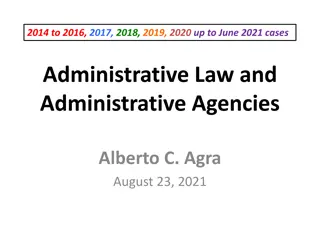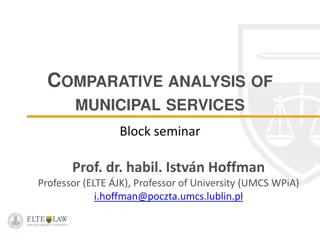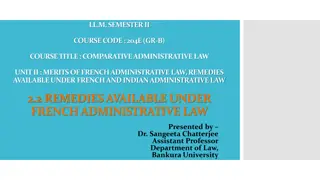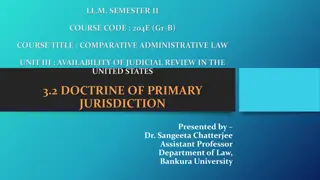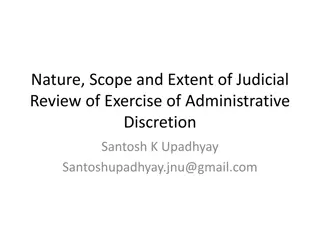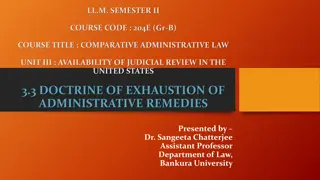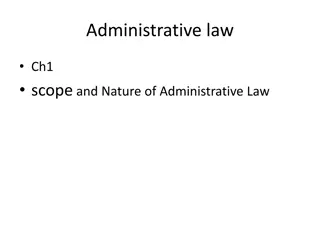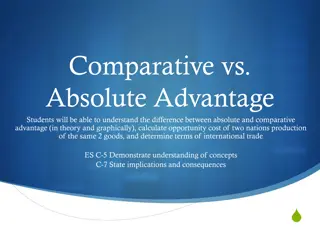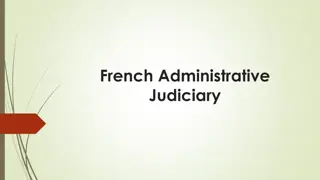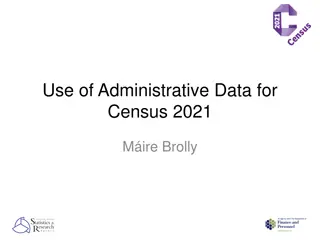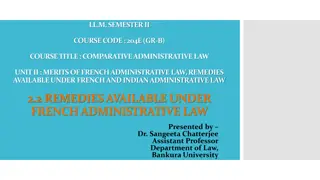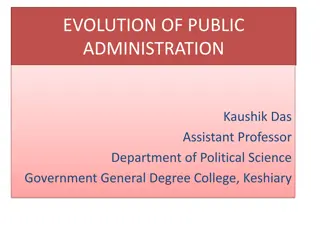Comparative Analysis of Administrative Law Regulations in Public Administration
This block seminar delves into the realm of administrative law regulations, exploring topics such as the concept of Love Law, different legal approaches, pluralism in Roman law, modern pluralism, challenges of comparison, levels of comparison, and methods of legal comparison. The discussion includes an analysis of functional and structural methods, genealogical and analogical comparison, and internal and external comparison in the context of public administration.
Download Presentation

Please find below an Image/Link to download the presentation.
The content on the website is provided AS IS for your information and personal use only. It may not be sold, licensed, or shared on other websites without obtaining consent from the author. Download presentation by click this link. If you encounter any issues during the download, it is possible that the publisher has removed the file from their server.
E N D
Presentation Transcript
I INTRODUCTION NTRODUCTION TO A ADMINISTRATIVE DMINISTRATIVE L LAW R REGULATIONS EGULATIONS ON THE THE P PUBLIC TO C COMPARATIVE OMPARATIVE AW P PART ART I I L LEGAL ON THE THE O ORGANISATION RGANISATION OF UBLIC A ADMINISTRATION DMINISTRATION Block seminar EGAL OF Prof. dr. habil. Istv n Hoffman Professor (ELTE JK), Professor of University (UMCS WPiA) i.hoffman@poczta.umcs.lublin.pl
Introduction Methods of legal comparison
The first question: What is Love Law? (1) Politics Law as an autopoetic system Morality Economics Social customs
The first question: What is Law? (2) The different approaches Postivism (Hart) Monism Dualism (for example: ius naturale ius positivum) Pluralism Different approaches of pluralism
Pluralism in Roman Law (Samuel, 2019, 144, after D.1.1.1.) Ius naturale (order in nature) Ius gentium (human reason) Ius civile (positive law)
Modern pluralism (Samuel, 2019, 144) Transnational legal culture regimes State legal culture regimes Internal legal cultures
Challenges of Comparison Law and Language expression, translation (distortion) Law and fact (actual and virtual facts)
Levels of comparison Micro (presumption of similarity) and macro (presumption of difference) approaches Genealogical and analogical comparison Genealogical: influence specific rules Analogical: institutions Internal and external comparison
Methods of legal comparison (1): main methods Functional: analysis of the functions of legal rules (social sciences!) Between functionalism and structuralism: Schemes of intelligibility Analysis of schemes Law and the dialectical schemes Structural: analysis of the structure Hermeneutical
Methods of legal comparison (2): Functional method (1): rule based analysis (Samuel) How is this function fulfilled in foreign system? Rule in home system Function of rule in home system Rule in foreign system Comparative conclusion
Methods of legal comparison (3): Functional method (2): case based analysis (Samuel) How would the facts of this case be decided in foreign system? Examination of similar fact cases in foreign systems Case in home system Comparison of reasoning and policy implications in home and foreign cases Policy implications
Methods of legal comparison (4): Structural method Application of the insider view Identification of the law system External view of foreign system
Comparative Administrative Law and Comparative Public Administration Legal and Administrative Comparison
Introductory remarks Analysis of the public administration: Different approaches Different elements Legal comparison and public administration The main field of the comparative law The evolvement and development of comparative administrative law comparative municipal law
Jurisprudential comparison Different levels of the comparison First level: country studies Second level: comparison of the legal institutions Formerly the majority of the books on comparative legal analysis: country studies Changing methods: see Bogdandy et al. (2014) and Rose-Ackermann et al. (2017)
Legal systems and administrative law (1) Legal systems (Ren , Zweigert/K tz) Common Law Continental French (Latin) German Scandinavian Eastern Central, Eastern and South Eastern European Traditional (Formerly: Socialist)
Tiers of legal comparison of the different systems (1) Legal culture (after Kuhlmann & Wollmann) based on traditional comparative law approach Common Law Roman French Roman German Roman Scandinavian Rule of Law (Rechtsstaat) vs. Public Interest Procedural models Common Law French German
Tiers of legal comparison of the different systems (2) Constitutional model Legal regulation on form of government) Presidential Semi-Presidential Parliamentary Council of Ministers Westminster Chancellor Federal or unitary state Federal Unitary Centralised Decentralised Regionalised
Comparative public administration (comparative governance) (1) Based on the methods of political sceinces, economics and partly jurisprudential elements administrative sciences Elements of the analysis (1) Comparative governance Administrative reforms (firstly NPM, form the 2000s post-NPM, Good Governance, NWS based etc.) Territorial aspects (economies of scale, borders, federalisation, regionalisation, centralisation, decentralisatiopn, devolution) Financial approaches (fiscal federalisation / decentralisation) Decision making
Comparative public administration (comparative governance) (2) Elements of analysis (2) Welfare models (Esping Andersen) Scandinavian (aka social democratic) Continental (aka conservative, aka Bismarckian) Southern European Anglo-Saxon (aka liberal)
Constitutional structures Constitutional structures of the different administrative systems
Major element: form of government Forms of government, based on the legal status of the Head of the State Monarchy Republic Forms of government, based on the the interactions and relationships of legislation and executive Non-democratic (authoritarian or hybrid): Monarchies: Absolut and Constitutional Monarchy Authoritarian Republic Democratic: Presidential Semi-presidential Parliamentary
Presidential republics Only in Republics (similarity: Constitutional Monarchy) Separation of powers and checks and balances Legislation Executive Head of the executive: the Head of the State (personal leadership!) Only legal responsibility to the Legislation: impeachment AND strong veto rights Transformation: independent agencies Judicial review of the actions of legislations and executive
Parliamentarism (1) Monarchies and republics Common element: government (executive) is politically responsible to the legislation Different types: Council of Ministers Ministers are personally responsible to legislation Prime Minister: primus inter pares Instability
Parliamentarism (2) Westminster model Only the Prime Minister is personally responsible to legislation Each voting in Parliament can be considered as a vote of confidence Destructive vote of confidence Cabinet system Chancellor democracy: Only the Prime Minister is personally responsible to legislation Constructive vote of confidence Judicial review and constituional courts
Semi-presidential model Between Parliamentarism and Presidential system Head of state is the Head of Government, but there are corporate governance : Council of Ministers, with a Prime Minister (and his/her legal status) Council of Ministers is responsible to Head of the State (President) Legislation (mainly: House of Representatives) Head of State can act widely independently
Territorial division based on the constitutions (1) Unitary and federel states Traditional concepts Federalism Local government Regionalisation as a phenomena Transformation of the traditional framework: Centralised or organic decentralised or dual federations Asymmetrical federalism Regionalisation and regionalism Evolvement of hybrid models (?)
Territorial division based on the constitutions (2) Trends in territorial governance The evolvement of the welfare state and the fiscal federalism Asymmetrical territorial reforms and the ethnic questions Based on the EU: regional development issue Decentralisation as a tool of the share of the powers Inter-municipality Methods of the comparison: Governance Jurisprudential and organisational approach
Administrative independence, transparency and policy-making Procedural elements
Transforming environment of administrative law Trust as a central element of the efficiency of administrative systems Concept of co-creation The role of resiliency Trust and resiliency in law: procedural solutions: Administrative independence as a professionalisation Accountability and transparency Policy-making: Citizen s involvement, form Community budgeting
Administrative independence (1) Different levels: Professional independence of the public servants (open recruitment, professional rules, depoliticisation) Regulatory authorities and independent agencies Professional independence Regulation on open recruitment and exceptions Instructions and contradictions Right to professional view Depoliticisation of civil servants (?)
Administrative independence (2) Regulatory authorities Evolvement (late 19th century, but mainly: after WW2). Regulatory roles: Decisions which have a general element Regulatory powers Soft law documents Independent agencies Evolvement answer to the Presidential Administration and its further evolution Characteristics Organisational Personal autonomy Professional Challenges Rule of law and independency Democratic legitimation and independency
Accountability and transparency Accountability and trust: different elements Remedies and judicial review: external control Constituional court Transparency Decision making Citizen s participation Decions Individual General (regualtions) Accountability External control (within the state): checks and balances Civil control Media (?) (even: social media?) and its challenges
Comparative analyses of the central government systems and bodies Central government and independent agencies
Different models Classification: Kuhlmann Wollmann Napoleonic Continental European federal (German Austrian) Scandinavian Anglo-Saxon Central Eastern and South Eastern European Fazekas: British Northern American (USA) German French Scandinavian
British model (1) UK, but this model is followed by Ireland, Canada, Australia and New Zealand Constitutional background King / Queen in Parliament Ultra vires principle Parliamentary monarchy (Ireland: republic) Royal prerogatives Royal charter Government and Cabinet Government: wide Cabinet: 20-30 members, members are selected by the PM Role of the PM: responsibility to Parliament, different posts which are held by the PM PMQ: Prime Minister s Question in Parliament
British model (2) Ministerial departments: Department/Ministry, but there are other bodies which are considered as ministerial departments (Traesury; Wales Office) Lead by Secretary of State (mainly) Secretary of States (Ministers) are responsible to Parliament: Parliament can review their regulations Permanent Secretary: professional head of the civil servants of the ministerial departments Non-ministerial departments, exectuive agencies, non-departmental public bodies Offices (for example National Health Service) or collegial bodies (Advisory Committee on Pesticides) They are established mainly by Act of Parliament, but in several cases by royal charter (for example the British Broadcasting Corporation BBC) Limited autonomy (some of them: regulatory authorities)
(Northern) American model (1) Based on the United States of America, it is folowed by several Latin American countries Presidential system: The Head of the State and the Head of the (federal) administration is the president Wide powers and duties of the president Executive Office of the President : the staff of the president ( West Wing ) Cabinet: mmbers: Secretaries, but there are another positions Department of Justice: Attorney General; Secretary of State as a secretary responsible for foreign affairs) Appointed by the president (but mainly approval of Senate is required) Departments Democratic legimitation: strong legislative control of buraucracy (personal questions, review of regulations) powers and duties of the Congress, but these powers can be delegated (delegation of powers)
(Northern) American model (2) Agencies Different names (Office, Bureau, Commission, Administration) Regulatory authorities Independent regulatory agencies Established by the Congress, leaders are appointed (mainly) by the President (in several cases approval of Senate is required)
German model (1) Model is followed by the V4 countries and several Southern European countries (from the 90s, especially Italy, Spain, partly Portugal and Greece) Parliamentary system Head of State (in Germany and Austria: Bundespr sident) is theoretically the Head of the Administration, but their role is mainly ceremonial: Appointments and recommendations (chancelor is recommended by the BP? but is elected by the Bundestag in Germany in Austria: chancellor is appointed by the BP). Countersign of the chancellor or miniszters are required for the majority of their actions.
German model (2) Government: Bundesregierung (Austria and Germany) Three principles: Chancellor principle (Kanzlerprinzip): the general politics of the government is defined by the chancellor and he or she is only responsible to legislation ( constructive vote on confidence the new chancellor shall be named by the motion of non-confidence) The role of the Office of the Chancellor (in Germany: Bundeskanzleramt) Lead by a minister Responsible for the intra-governmental coordination and for the inter-governmental relations Departmental principle (Ressortprinzip) There are ministries within the government which are lead by ministers and which are responsibles for their sectors Collegiate principle (Kollegialprinzip) Government is a collegiate body, however the chancellor has pominent role
German model (3) Ministries Sectoral division Dual structure: Political leadership: Minister and Political Secretary of State (politischer Staatsskeret r(in)) politically sensitive and changing Professional leadership: Administrative Secretary of State (beamteter Staatssekret r(in)) permanent and stable (?) but political loyality is important Non-ministerial departments and agencies (Oberbeh rde) Mainly directed by a ministry Established mainly by Act of Parliaments
French model (1) Followed: by France and the Francophone countries (in Europe: Eastern European countries, Romania, partly by several West Balkan countries) 5th Republic (de Gaulle) Semi-presidential model Executive is lead by the President (Pr sident) and by the Government (Gouvernement) which has a Prime Ministre (Premier ministre) President: Head of State, wide responsibilites in the field of defense policy and foreign policy (the structure was developed by the Gaulle ) but: wide range of requirement of ministerial countersign
French model (2) Government: It is led mainly by the President (it is called: Conseil des ministres) but it can be led by the Prime Minister (it is called: Conseil de Cabinet) Members: Prime Minister and Ministers (they cannot be members of the National Assembly) Government is responsible to the National Assembly and to the President (Formerly co-habitation was an opportunity different political views of President and Prime Minister but now the termins of National Assembly and President has been harmonised) Wide range of executive regulatory powers (decrees and ordonnances) Prime Minister Prominent role in the Government Regulatory powers Office (responsible for governmental coordination): Secr tariat G n ral du Gouvernenmant
French model (3) Ministers and ministries Different positions (Ministre d tat) Ministre (Ministre d l gu ) Dual structure: Political component: Miniszter, Cabinet of the Ministre, Secretary of State Professional component: lead by Secretary General (Director Generals and Directors) A special body: Conseil d tat A special administrative body with wide range of autonomy Formally is led by the Prime Minister, but actually led by the Vice-President of the Conseil d tat Responsible for the judicial review of the administrative decisions and regulations Advisory body to the President and to the Government since 2019: only ministers
Scandinavian (Nordic) model Mainly: parliamentary monarchies (except: Finland and Iceland) King/Queen: in theory the Head of Executive, but practically only ceremonial roles Executive is led by the Government Council of State can be established (in Denmark: St tsradet, which members are wider, for example the Crown Prince is a Member, as well) Government is responsible to the legislation but appointment cvan be different (the Government can control the decisions of the King/Queen) Prominent role of the PM Dual structure of ministries (political and professional) in Sweden:more than one minister in one ministry (but there is a main one, the others are responsible for sub- sectors within the ministry) Prominent role of agencies In Denmark: directed by the ministries In Sweden: autonomy and wide powers and duties
Comparative analysis of the police administration
The interpretation of policing Different approaches Common element: defense of the public order French approach: ordre publique and its elements German concept of Polizei Anglo-Saxon countries: police to protect and serve
The beginning: medieval ages Feudal policing The tasks of the municipalities State polices: absolute monarchies
Municipal police Anglo-Saxon countries General police tasks are performed by municipal bodies State polices and and municipal polices



